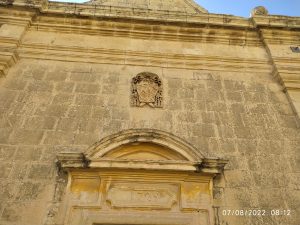
WELCOME!
to
The Chapel of St. Paul’s Shipwreck
View the eBook below to learn all about the Chapel and the restoration work that was done to it
(written in Maltese)
St Paul’s Chapel is one of a number of chapels found in Attard. Originally, on the same site at Taħt ir-Raħal, another chapel had been built in 1628, dedicated to the Assumption of Our Lady, according to a manuscript by the priest Gio Batta Sammut.
1500 is given elsewhere as the year in which the old chapel dedicated to the Assumption was built. Sammut states that his sources were Padre Pelagio and certain old documents, which Sammut himself summarised. The Assumption Chapel was desecrated by Mgr Alpheran de Bussan in 1728; it was demolished and rebuilt in 1729 and dedicated to St Paul Shipwrecked.
Original documents listing the expenses incurred for the cutting and construction of the chapel’s foundation, are dated December 1728, while the building was completed in 1729. The sum incurred for the building of this chapel amounted to 205 scudi, eight tari and six grani.
The chapel’s façade consists of one bay defined by two corner pilasters of the Doric order. Above the central doorway, which is decorated with mouldings, is a frieze with the year 1729 in relief. Above the frieze lies a segmental pediment. Further above, right in the centre, is Mgr. Alpheran de Bussan’s coat of arms in relief.
On both sides of the doorway are two small windows, which according to evidence found on the internal windowsills, indicate that the window was used for the collection of alms. The façade is terminated by an architrave, frieze and cornice surmounted by a frontispiece crowned by a cross. At the sides there are two oval finials. At the sides of the chapel, at roof level, there are two waterspouts.
On each side of the chapel are two clerestory windows. On the corner Doric pilaster adjacent to the main façade there is a sundial. At roof level there are two belfries, one next to the stairwell and the other next to one of the oval finials.
Internally the chapel consists of one main central space roofed over by a barrel vault, under which runs a cornice. There is one main altar made of stone, and a space behind in the shape of an apse. Above and behind the altar there is a decorated stone framework, which embraced the titular painting. At the top of this stone framework, there exists the relief of two puttini holding a circular stone frame topped by a shell. A string of bay leaves flow along the sides of the stone framework.
The titular painting depicts St Paul with St Publius and St Vincent de Paul, who were all venerated. Documents reveal a payment of 20 scudi to Arrigo Ornace, probably the author of the titular painting. Another four paintings depict the evangelists, which used to hang embraced by stone frames at the sides of the chapel. These paintings are attributed to Francesco Zahra. At present the titular altarpiece is at the parish museum, and the other four paintings are hanging in the parish church sacristy.

The Chapel of Saint Paul’s Shipwreck
This Church is a typical, simple rural chapel. The coat of arms on the front belongs to Bishop Paolo Alpheran de Bussan.
According to historian Achille Ferris, writing in 1866, there used to be another chapel dedicated to the Assumption of Saint Mary on this site. Instead of this chapel which probably fell into disrepair, a new chapel was built between 1728 and 1729.
The new chapel is dedicated to Saint Paul’s Shipwreck.
‘Paul’ was the namesake of the Bishop of the time. The painting on the altar is by Enrico Regnaud (1692-1764) and shows Saint Paul, Saint Publius and Saint Francis of Paola.
This chapel was painstakingly restored between 2005 and 2008 and mass is celebrated regularly, not least on the feast of the shipwreck of Saint Paul on the 10th of February a public holiday in Malta.